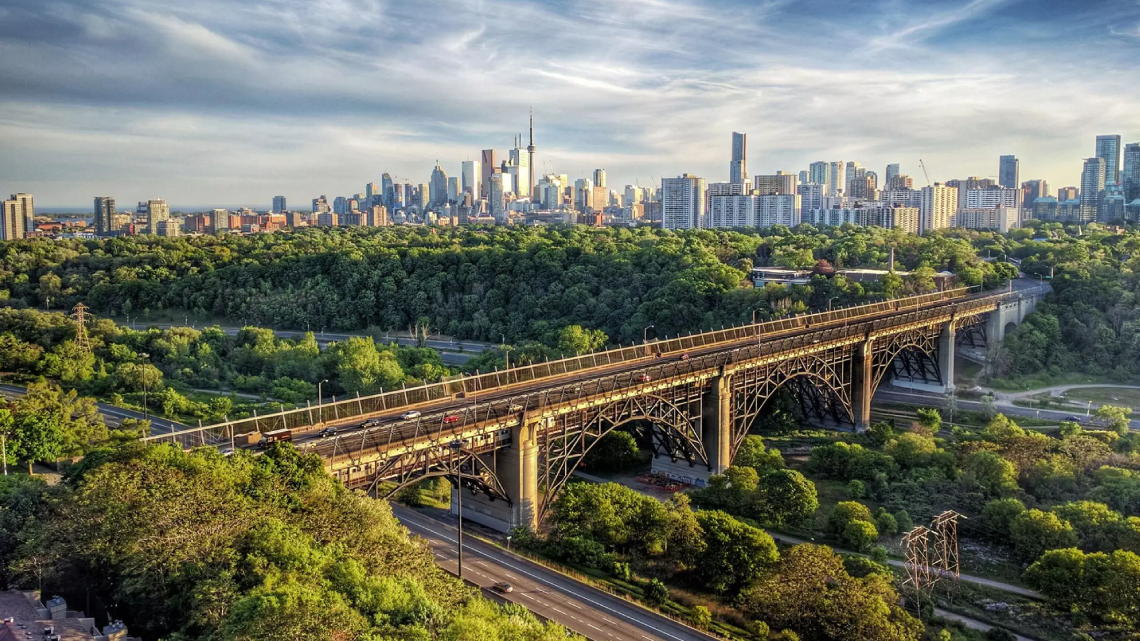The Bloor Viaduct, a defining feature of Toronto’s skyline, has stood tall since its construction between 1914 and 1918. Officially named the Prince Edward Viaduct, its colloquial reference as the Bloor Viaduct persists among Torontonians. Beyond its iconic facade, there are intriguing facets often overlooked by the public.
1. Three Parts, One Structure
Contrary to popular belief, the Bloor Viaduct is not a singular bridge but a composite project comprising three distinct sections. The roadway between Sherbourne and Parliament utilizes fill, followed by a bridge spanning Rosedale Valley and the renowned section over the Don Valley.
2. The Secret Fourth Component
Adding a touch of secrecy, the covered subway bridge constructed in 1966 between Castle Frank and Sherbourne stations forms an honorary part of the viaduct. Originally not part of the design, it addresses the challenging curve between the subway platform beneath the Don section and the Rosedale section.
3. Evolving Designs: From Concept to Reality
Initial designs envisioned a bridge directly connecting Bloor St. East to the Danforth. However, concerns about the impact on the Rosedale ravine led to the adoption of the three-part design we see today.
4. Overcoming Controversies: Three Tries to Build
The viaduct faced controversy from its inception, with four public referenda held on its construction. The final approval came in 1913 when the current meandering route was adopted, addressing concerns and gaining public acceptance.
5. A Dark History: Suicide Prevention Measures
In a sombre turn of history, the Bloor Viaduct was once a notorious spot for suicides. The installation of the Luminous Veil in 2003, enhanced with lights in 2015, significantly curtailed such incidents, preventing approximately 60 suicides annually.
Preserving Heritage: Bloor Viaduct’s Time-Tested Resilience
As a testament to its enduring significance, the Bloor Viaduct underwent transformations in response to evolving needs and challenges. The addition of the covered subway bridge in 1966 demonstrates the adaptability of this iconic structure. Serving as a vital link between Castle Frank and Sherbourne stations, this unassuming component quietly contributes to the viaduct’s functional legacy.
Architectural Evolution and Public Sentiment
The evolution of the Bloor Viaduct’s design reflects a delicate balance between functionality and community considerations. The bridge’s initial controversy and multiple design iterations highlight the complex interplay of public sentiment and infrastructure development. Ultimately, the adopted three-part design not only addressed practical concerns but also preserved the natural beauty of the Rosedale ravine.
Illuminating Hope: The Luminous Veil’s Impact
While the Bloor Viaduct has faced its share of challenges and controversies, the implementation of the Luminous Veil stands as a beacon of hope and innovation. Acting as a suicide prevention measure, this intricate veil not only adds an artistic touch to the viaduct but, more importantly, has been a crucial element in saving lives and transforming the bridge into a symbol of resilience and community care.
Pritish Kumar Halder
Delving into Toronto’s architectural wonders and historical landmarks, Pritish Kumar Halder captures the essence of the city’s rich heritage. A passionate explorer of hidden narratives, he uncovers lesser-known facets that add depth to familiar structures. Follow Pritish for a unique perspective on Toronto’s urban tapestry.










